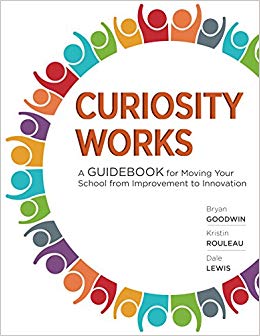By Bryan Goodwin
CEO, McREL International
School reform reminds me of the old joke about the light bulb undergoing Freudian analysis. Like the bulb, your school must want to be changed. Since the 1980s, however, what educators want hasn’t been taken into much account.
Instead, reform has largely been a “top down” affair, with expectations, incentives, and disincentives tumbling from state and federal legislatures into schools and classrooms, where they can add confusion and frustration to already-demanding work.
The reform movement hasn’t been all bad—it has helped to boost student outcomes in some places for some periods of time—but it’s taken a toll on educator morale and empowerment. I think that teaching and learning should be exciting, everywhere, all the time. And I’m convinced they can be.
School-driven improvement and innovation
It makes sense to me that school improvement and innovation should begin in school. When a school changes from the inside out—that is, because the people in the school genuinely want the change and have a true say in how they’ll go about creating the change—there are no limits to what they can achieve.
The key is curiosity, a characteristic that’s innate in all of us but needs to be nurtured to be effective. With a few ground rules (but really, not that many) any school leadership team can harness curiosity to produce great results for their entire school community.
That word—team—is important. Change, improvement, and innovation cannot happen through the sheer willpower of an individual principal working solo. It takes a team of invested and empowered teacher leaders, support staff, and administrators working together.
Your school innovation team
How do you get that team up and running? Here are some ideas, drawn from McREL’s recent book, Curiosity Works: A Guidebook for Moving Your School from Improvement to Innovation.
 First and most important, the team personifies the conviction that leadership is most effective when it’s shared. Fifty years of research on shared leadership in a variety of industries has found these common benefits: increased team efficacy, effort, collaboration and coordination; innovative problem solving; satisfaction; citizenship behavior, and performance.
First and most important, the team personifies the conviction that leadership is most effective when it’s shared. Fifty years of research on shared leadership in a variety of industries has found these common benefits: increased team efficacy, effort, collaboration and coordination; innovative problem solving; satisfaction; citizenship behavior, and performance.
Team members should be willing to meet at least monthly for a year or more (with staggered terms to ensure continuity), and to dig in on subjects that may be outside their direct experience, such as data analysis and management theory. Members should represent various grade levels, subject areas, and job roles, so that the whole building feels represented at the table.
Although data will be on the agenda at many if not most meetings, this process is about hopes, dreams, and values as much as it is about numbers. If honest communication is happening, you can expect a broad range of emotions to pour forth in meetings.
An important starting point for the team is identifying a shared moral purpose, which is an important precursor to later decisions the team will make, like setting up a professional development plan. Team members need to ask each other (and themselves) why they became educators in the first place. “For the money,” someone will probably joke, and everyone can have a little laugh. But then, seriously: Why?
Ask yourselves some probing questions
Here, from Curiosity Works, are some reflection questions for your school leadership team members:
- How do you maintain focus on your school as a whole, taking a systems perspective rather than focusing solely on your own area of daily responsibility?
- When competing demands emerge, and energy for improvement and innovation subsides, how do you help staff stay focused on improving?
- What systems do you have in place for reviewing progress toward goals?
- What information do you collect about how individuals and groups are experiencing and managing change? How is this information collected?
The path to improvement and innovation doesn’t really have an end point, because it’s something that should happen continually. And it’s not primarily about “quick wins” (although there will be some along the way, and they’ll be legitimate causes for celebration). But it does have a starting point, so if your school is eager to get going, putting the team together is the way to do it.
Read more about McREL’s take on the power of curiosity.
 Bryan Goodwin, CEO of the Denver-based nonprofit McREL International, thrives on translating education research into practice, scanning the world for new insights and best practices, and helping educators adapt them to address their own challenges. Bryan is the co-author of Unstuck: How Curiosity, Peer Coaching, and Teaming Can Change Your School (reviewed here). His most recent book, Out of Curiosity: Restoring the Power of Hungry Minds for Better Schools, Workplaces and Lives, is due out in September. Also, investigate the Unleashing Curiosity series from McREL.
Bryan Goodwin, CEO of the Denver-based nonprofit McREL International, thrives on translating education research into practice, scanning the world for new insights and best practices, and helping educators adapt them to address their own challenges. Bryan is the co-author of Unstuck: How Curiosity, Peer Coaching, and Teaming Can Change Your School (reviewed here). His most recent book, Out of Curiosity: Restoring the Power of Hungry Minds for Better Schools, Workplaces and Lives, is due out in September. Also, investigate the Unleashing Curiosity series from McREL.


0 Comments on "“Inside-Out” Innovation? Start with the Curiosity Inside Your School"